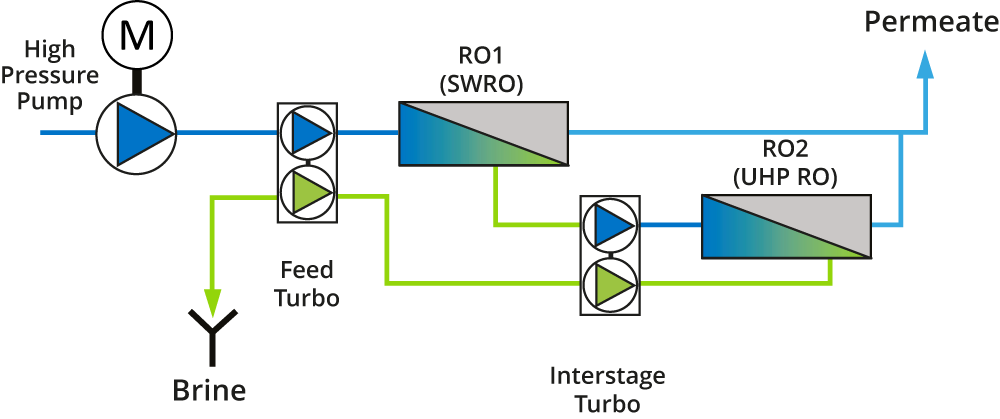Sistemas de vertido cero
Para mayor seguridad en la ósmosis inversa de ultra alta presión
- Minimización de la descarga de salmuera
- Reducción o eliminación de los requisitos de evaporación
- Recover de minerales valiosos

En un sistema de ósmosis inversa multietapa, sólo la última etapa de la membrana funciona por encima de la presión de la SWRO convencional (82 bares/1.200 psi).
El turbocargador HPB-Ultra proporciona este refuerzo sin necesidad de bombas de alta presión ni motores de alta velocidad.
.
.png?width=180&height=170&name=HPB-500%20V1.8%20(1).png)
La creciente demanda de ZLD y de extracción de salmueras supone un nuevo paradigma para la ósmosis inversa de alta recuperación.
Refuerce su sistema de ósmosis inversa de ultra alta presión de forma segura, eficiente y flexible con el turbocargador HPB Ultra.
We are constructing more desalination capacity than ever, but traditional single-stage membrane arrays dominate
Small increases to recovery come at the cost of higher biofouling, higher chemical consumption and shorter membrane life
Large arrays of isobaric ERDs also struggle to maintain consistent energy transfer, and introduce brine-feed mixing
MAXIMICE LA RECUPERACIÓN EN LA ÓSMOSIS INVERSA
- Reducza los costes de eliminación de la salmuera
- Minimice el espacio requerido para reducir el impacto en las operaciones.
- Consiga altas tasas de recuperación con un rendimiento óptimo del membrana
DISEÑO ORIENTADO A LA INDUSTRIA
- Maximice le fiabilidad con turbocargadores dinámicamente equilibrados y sin motor
- Equipos con un tamaño pequeño para minimizar el impacto en las operaciones in situ
- Mejore la seguridad y reduzca los niveles de ruido: minimice las piezas giratorias que funcionan a presión ultra alta.
As the push for sustainability and regulations limiting wastewater discharge volumes continue to increase, industrial water users are turning to water recycling and brine concentration through Minimal Liquid Discharge (MLD) and Zero Liquid Discharge (ZLD) facilities. Conventional approaches using evaporation are expensive, energy-intensive, and operationally challenging, making the case for maximizing recovery from waste streams more compelling than ever before.
However, achieving top brine concentrations beyond 100,000 ppm has traditionally been challenging for reverse osmosis (RO) technology. At every scale, the need for a simple and reliable solution to the membrane brine concentration challenge is clear. Let us help you push the boundaries of what RO technology can achieve.
Advantages of multi-stage, ultra-high-pressure RO using interstage turbochargers:
- Achieve top brine concentration up to 120,000 ppm without complex system configurations or challenging operating conditions
- Simple and reliable solution to the membrane brine concentration challenge
- Energy-efficient and cost-effective compared to conventional approaches using evaporation
Read the technical paper linked below to find out more about applying ultra-high-pressure turbochargers to industrial wastewater treatment and ZLD.
Find out more:
- Product specifications: text here
- Technical paper: text here
Contact our sales team to find out more about our products and services.
Interstage boosting is commonly used in brackish water reverse osmosis (BWRO) to balance flux between multiple RO stages. This achieves more stable membrane performance and higher recovery rates.
Using a turbocharger for your system's interstage boosting needs avoids using additional energy, and saves CAPEX on a booster pump, motor and variable frequency drive. It is also highly compact and operates with close to zero noise and vibration.
Interstage boosting is an ideal solution to handling high recovery applications or variable feedwater quality. See the case study below to find out more.
Find out more:
- Product specifications: Learn more about the HPB turbocharger
- Technical guide: In-depth study of centrifugal energy recovery devices
- Case study: Addressing variable feed quality using interstage boosting.
Contact our sales team to find out more about our products and services.
As the push for sustainability and regulations limiting wastewater discharge volumes continue to increase, industrial water users are turning to water recycling and brine concentration through Minimal Liquid Discharge (MLD) and Zero Liquid Discharge (ZLD) facilities. Conventional approaches using evaporation are expensive, energy-intensive, and operationally challenging, making the case for maximizing recovery from waste streams more compelling than ever before.
However, achieving top brine concentrations beyond 100,000 ppm has traditionally been challenging for reverse osmosis (RO) technology. At every scale, the need for a simple and reliable solution to the membrane brine concentration challenge is clear. Let us help you push the boundaries of what RO technology can achieve.
Advantages of multi-stage, ultra-high-pressure RO using interstage turbochargers:
- Achieve top brine concentration up to 120,000 ppm without complex system configurations or challenging operating conditions
- Simple and reliable solution to the membrane brine concentration challenge
- Energy-efficient and cost-effective compared to conventional approaches using evaporation
Read the technical paper linked below to find out more about applying ultra-high-pressure turbochargers to industrial wastewater treatment and ZLD.
Find out more:
- Product specifications: text here
- Technical paper: text here
Contact our sales team to find out more about our products and services.

